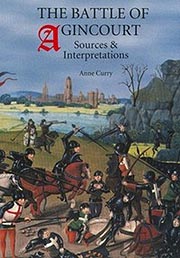
De Re Militari | Book Reviews
Anne Curry
The Battle of Agincourt. Sources and Interpretations
Warfare in History (Woodbridge: Boydell & Brewer, 2000), 490pp. $90.00/£50.00. ISBN: 0-85115-802-1.
See also the review of the PB
As history students develop into historians, they must learn to appreciate historiographical analysis, and they must learn to work effectively with original source material, both documentary and narrative, fragmentary, conflicting, and difficult though the evidence it provides might be. At least since Sir Nicholas Harris Nicolas published his History of the Battle of Agincourt in 1827, the famous combat of St. Crispin’s Day has offered exceptional opportunities for students and educators engaged in this process. Battles, by definition, are dramatic events, characterized by unity in time, space, and action. They easily arouse the curiosity and hold the attention of modern readers, just as they did of contemporaries. And of all medieval battles, Agincourt is probably the most richly documented. Perusing Anne Curry’s outstanding new book, The Battle of Agincourt: Sources and Interpretations, makes this very clear. Curry has assembled, in translation, no fewer than twenty-six chroniclers’ accounts of the campaign, amounting to 170 printed pages. But that is just the beginning. She has also provided another fifty-odd pages of fiscal and administrative accounts relating to the battle, such as service indentures, pay accounts, letters written during the campaign, and the relatively recently-discovered French battle plan drawn up a week or two prior to the engagement. All of these texts are provided with ample and thoughtful introductions, so that students can approach them with some degree of sophistication. Some have never before appeared in print; many have not previously been translated into English. Curry’s book thus offers students a far richer mine than Nicolas’ older compilation, which itself was sufficient to sustain John Keegan’s insightful treatment of the battle.
The collection of source material is so extensive, and the translations are generally so clear and reliable, that in two articles I recently wrote on the campaign and battle of Agincourt, I was able to refer readers to Curry’s volume for the large majority of my footnotes. The one minor source I noticed as missing from her book (the Scottish Liber pluscardensis) was much outweighed by the inclusion of many materials I would likely have overlooked had she not presented them, such as the allegorical poem Le pastorelet and the valuable excerpt from a 1460 succession court case, which is the only source to tell us how far behind the vanguard the main French division was stationed. There were only perhaps three or four instances where I disagreed significantly with her translations, out of dozens.
In addition, the book includes several sets of material which can be used as a case-study in the evolution of the historical discipline itself, traced through the reactions of contemporaries, the texts of sixteenth-century historians, and Curry’s summary analyses of the writings of historians of the eighteenth, nineteenth, and twentieth centuries. As the best volume to date in Boydell’s Sources and Interpretations series, this book therefore would be an excellent one to use in a historical methodologies course at the undergraduate or graduate level. I recommend it heartily for the collections of all college libraries, and all De Re Militari members.
